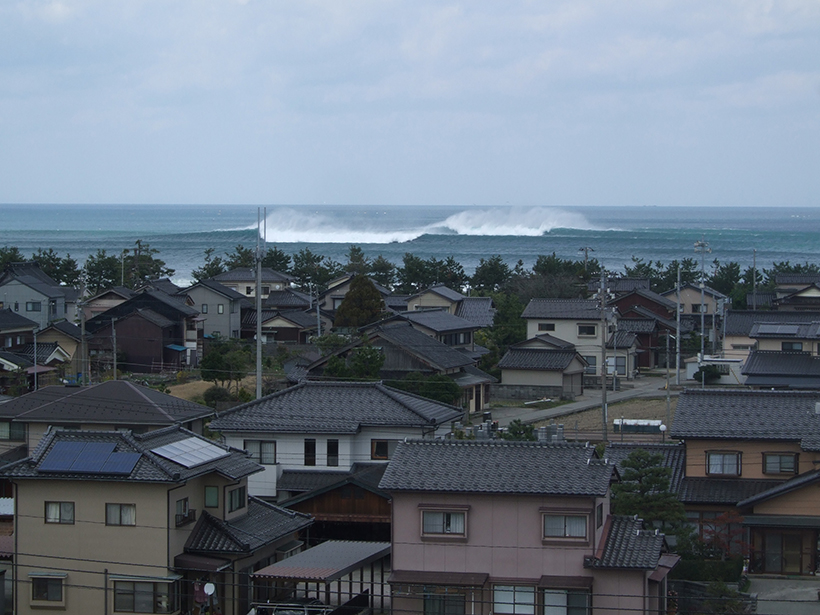Locals in Toyama Bay, Japan, have a name for strange winter waves that arrive out of nowhere: YoriMawari-nami. The waves can reach nearly 10 meters (32 feet) and batter the shoreline for as long as a day, bringing wave after wave of crushing power. Some have even grounded cargo ships and snapped concrete barriers like twigs.
Scientists don’t know how the waves form, and local forecasting models can’t predict them.
In February 2008, a wall of YoriMawari-nami pummeled towns along the bay, destroying 200 houses, flooding streets, killing two people, and injuring 18. The waves have been documented for centuries, but scientists don’t know how the waves form, and local forecasting models can’t predict them.
Hitoshi Tamura, a senior researcher at Japan’s Port and Airport Research Institute, set out to create a model that could better represent the waves. In the process, he uncovered a new characteristic of YoriMawari-nami that could be key to forecasting them successfully and even found links to a classic experiment by a 19th century physicist.
The Making of a Wave
Waves coming into Toyama Bay are very “clean,” said Tamura, because they all come from one direction. When winter storms whip up ocean swells traveling toward the bay in all directions, the shape of the bay’s peninsula allows only ocean swells from the north-northeast to travel ashore. The waves coming ashore are abnormally regular and unidirectional, said Tamura. “The wave shape is very beautiful.”
The clean waves can reap destruction, however, when they travel over submarine canyons lining the bay’s coastline. The submarine canyons look much like valleys below water, with cascading walls and gullies that stretch from the continental shelf down to the deeper ocean.

Tamura showed that the submarine canyons focus the clean swells “like a lens.” As surface waves speed toward the shoreline, they interact with the ocean bottom. Incoming waves refract, or bend, over the canyon, and in some places, the waves meet in focal zones. At some meeting points, the waves positively combine, summing to a much larger wave height than their individual contributions. In other areas, the waves cancel each other out and have a lower wave height.
The effect is similar to a 19th century experiment conducted by physicist Thomas Young called the double-slit experiment. In Young’s experiment, sunlight passes through a small slit in a screen, letting through a smidge of light in the same frequency. The light then encounters another screen—this one with two slits—that redirects the light in different directions. On the final screen, you see how the light coming through the two slits interacts positively and negatively, creating light and dark patterns. The interaction is called coherent interference, and it is the key to YoriMawari-nami waves, said Tamura.
Swells on the Horizon
Coherent interference occurs elsewhere in the ocean, like just offshore Half Moon Bay, Calif., a popular spot among surfers. Perhaps the most famous example is in Nazaré, Portugal, where surfers can ride some of the most massive waves in the world, including the Guinness World Records’ largest wave ever surfed, 24.38 meters (80 feet) tall. The waves in Nazaré form from a submarine canyon that focuses and bends waves into behemoths.
Tamura said that despite their ubiquity, conventional forecasting models average out a particular attribute of waves, called phase, that is critical to calculating coherent interference. Tamura’s models include an extra term in the model’s equation to account for phase relationships, and Tamura hopes to combine models to create more powerful local forecasts.
Failing to account for interference can complicate navigation and lead to “gross underestimations of wave height prediction.”
Researcher Pieter Bart Smit has studied coherent interference from submarine canyons off the coast of La Jolla, Calif., and said that Tamura and his collaborators “convincingly demonstrate that the observations can be explained if wave focusing is properly accounted for.” Smit, the head of ocean research at Sofar Ocean Technologies who was not involved in the research, said that failing to account for interference can complicate navigation and lead to “gross underestimations of wave height prediction.”
Tamura hopes to collect data to test his hypothesis by placing buoys over the submarine canyons in Toyama Bay and watching how the waves propagate in the real world. If he does this, he won’t have to wait long for data: Historical records show that about two YoriMawari-nami wave events occur each year.
“The hope is that I can generate a prediction system to predict YoriMawari-nami waves, so it can contribute to the coastal area and local people,” Tamura said. “That should be the final goal.”
Tamura presented his work at the Ocean Sciences Meeting 2020 in San Diego, Calif., and published the research in the Journal of Geophysical Research: Oceans last month.
—Jenessa Duncombe (@jrdscience), News Writing and Production Fellow
Citation:
Duncombe, J. (2020), Submarine canyons breed megawaves in Japan, Eos, 101, https://doi.org/10.1029/2020EO140681. Published on 21 February 2020.
Text © 2020. AGU. CC BY-NC-ND 3.0
Except where otherwise noted, images are subject to copyright. Any reuse without express permission from the copyright owner is prohibited.

